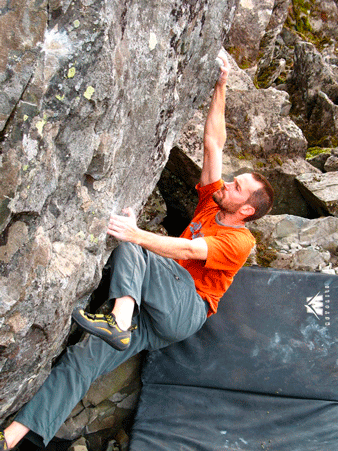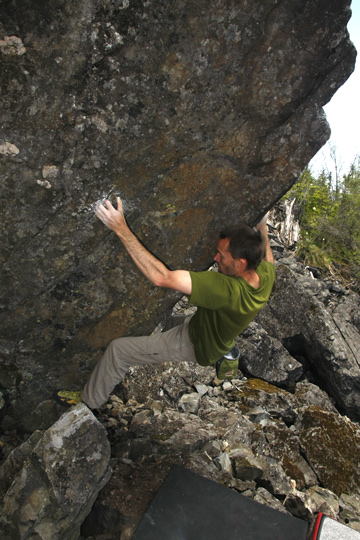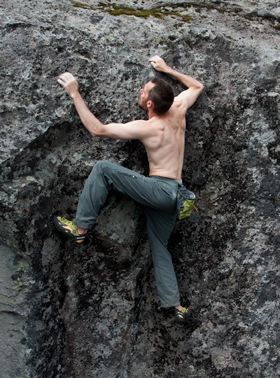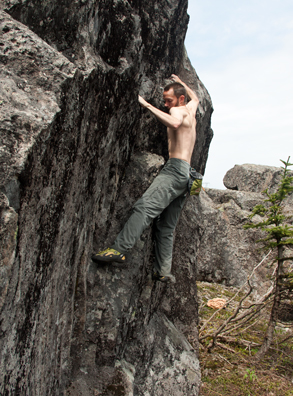The definitive go-to website resource for bouldering here is Portland Bouldering.NET. That website provides crucial info on each bouldering site, resource specific data and road/trail maps. The website includes a powerhouse list of what and where to go for you to tap into the array of opportunities for outdoor bouldering in this region.
The following is a brief analysis discussing a variety of quality regional bouldering sites. All of these bouldering sites are located near Portland, Oregon, or within a relatively short drive (20-80 miles) within the Northwest Oregon or Southwest Washington regions. The array of unique quality bouldering-sized stone found within this region suitably brings to the game of bouldering a surprisingly comprehensive finite wealth of stratigraphical and aspectual diversity. The characteristic types and structures of igneous (volcanic and plutonic) and metamorphic rock provide the key that enhances the zeal for people to enjoy the outdoor activity of Bouldering in this extensive Oregon and Washington region. The common rock types scattered throughout this region that are useful for bouldering are: basalt, basaltic-andesite, andesite, and some dacite formations (this region is not known for granite).
Looking for great outdoor bouldering opportunities? From mid-May through October cool bouldering options are plentiful locally and within a short drive from Portland. The warmer moderate temperatures quickly evaporate excess rain and dampness from the rocks, and light breezes tend to keep it reasonable for bouldering throughout much of the summer season.
Though Portland is not a premier destination for bouldering, of the minor bouldering sites that we do have available some have become very popular, such as Carver Boulders, Hamilton Boulders, and Empire Boulders.
The Larch Mtn bouldering site is a quality addition to the Portland bouldering scene.
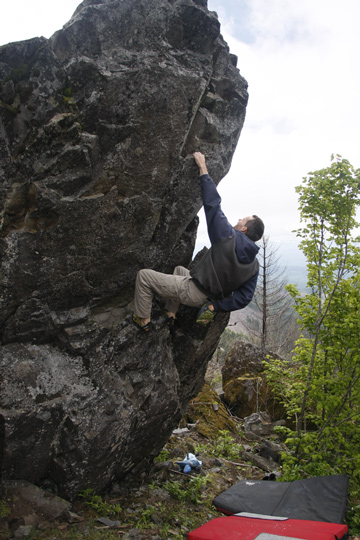 The site has the potential for virtually endless bouldering opportunities, and presently has problems ranging from VB to V8 (potential to V10+).
This site is a combination of boulders and rocky outcrops composed of high quality peripheral granodiorite formations.
Many high-ball problems (12' - 35' tall), low-ball problems, and some stellar long rail traverses.
The area is quite vast in scope, but certain sections are more popular, such as the Wild West bluff formation at the top of second knoll east of Larch Mtn.
All of road L-1000 and (as of early April 2014) the road L1500 has been improved considerably (its still gravel) for two-wheel drive city vehicles. There are TWO east gates now, a big yellow one, and another one blocking the old L-1510 road that went uphill for 1/2 mile to the Wild West Bluff. You will now need to walk up this slope to reach the bluffs and boulders up there. Walking up this final steep grade will take about 15 minutes.
Bouldering is feasible even in December with enjoyable bouldering on classic stuff in sunny balmy 55°F+ temperatures.
Sunshine and scenic views are plentiful on this ridgecrest knoll. Get out of that rut and go check it out.
The site has the potential for virtually endless bouldering opportunities, and presently has problems ranging from VB to V8 (potential to V10+).
This site is a combination of boulders and rocky outcrops composed of high quality peripheral granodiorite formations.
Many high-ball problems (12' - 35' tall), low-ball problems, and some stellar long rail traverses.
The area is quite vast in scope, but certain sections are more popular, such as the Wild West bluff formation at the top of second knoll east of Larch Mtn.
All of road L-1000 and (as of early April 2014) the road L1500 has been improved considerably (its still gravel) for two-wheel drive city vehicles. There are TWO east gates now, a big yellow one, and another one blocking the old L-1510 road that went uphill for 1/2 mile to the Wild West Bluff. You will now need to walk up this slope to reach the bluffs and boulders up there. Walking up this final steep grade will take about 15 minutes.
Bouldering is feasible even in December with enjoyable bouldering on classic stuff in sunny balmy 55°F+ temperatures.
Sunshine and scenic views are plentiful on this ridgecrest knoll. Get out of that rut and go check it out.
Directions to LMB: Drive north from Camas, WA on State 500 road, then east at Fern Prairie store. Drive north on Livingston Road. Turn right onto gravel L1000 forest road and drive for 2 miles to a 4-way intersection. Turn right and drive uphill (east) on gravel forest road L1500 for 1 mile to a place where L1500 road veers abruptly right at a yellow gate. Continue on this relatively flat stretch of road for 2 miles to the east yellow gate. Park here and walk uphill on a gated road 1/4 mile to the Wild West bluff knoll.
Cascade Locks Boulders offers andesitic boulders typically 9' - 16' tall in a forested setting.
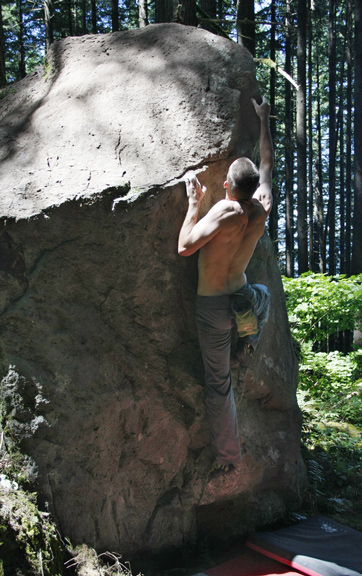 This site has year-round advantages that make it worth the short drive.
Paved road the entire distance to the parking spot. A mere short easy forested dirt road with 5-to-15 minutes of walking to the site.
Season: Typical 5-1/2 month season window from mid-May through October, but extends to year-round bouldering when there are rain-free days in winter.
This is rapidly becoming a great little winter spot due to its unique low elevation locale where the winds quickly evaporate the moisture off from the boulders.
Some minimal poison oak but easily avoidable. When visiting here be prepared to start your own new bouldering project.
Site has potential for many bouldering opportunities, but presently has VB to V6 problems to date, but has potential to V10+.
This site has year-round advantages that make it worth the short drive.
Paved road the entire distance to the parking spot. A mere short easy forested dirt road with 5-to-15 minutes of walking to the site.
Season: Typical 5-1/2 month season window from mid-May through October, but extends to year-round bouldering when there are rain-free days in winter.
This is rapidly becoming a great little winter spot due to its unique low elevation locale where the winds quickly evaporate the moisture off from the boulders.
Some minimal poison oak but easily avoidable. When visiting here be prepared to start your own new bouldering project.
Site has potential for many bouldering opportunities, but presently has VB to V6 problems to date, but has potential to V10+.
Directions to CLB: drive I-84 freeway east from Portland to Cascade Locks, Oregon. Drive through the heart of town on the main drag. At the east end of town the main road goes under the freeway and stops at a 4-way junction. At the 4-way junction continue straight (the weigh station road crosses here back onto the freeway eastbound). The road curls immediately east again. Drive on this secondary road next to the freeway for perhaps 1.3 miles (passing the Herman Creek Campground). At the next onramp/offramp junction, turn right (east) on another secondary road and drive briefly uphill for 1/4 mile and park at NF2800-022, which has a steel gated road on your right. See the diagram in the NW Oregon Rock guidebook for an overview of the general area and some of the common boulders.
Lost Lake Boulders is one of the superb new additions to the NW Oregon bouldering scene. This is a unique place where you will find a plethora of boulder problems ranging from VB to V10+. See PB website for more specific info, maps, and directions: Lost Lake Boulders.
Carver Boulders is the original first bouldering scene in Portland. For more info browse Spencer's web link for Carver Boulders and the Carver Climbing Club site to learn of the process and rules applicable for all users at the site.
Bridge of the gods boulders on the the Washington side of the Columbia River is a reasonable place in the cooler months from October to April. The place has a fair amount of poison oak during the warmer season, but is less of a nuisance in winter. It is a fairly open site so the boulders tend to dry out quickly even in the winter. The best of the andesitic boulders in this vast area tend to be in small clustered strings, but friends continue to explore the area and are still finding new gems.
The Schwingus near Rocky Butte in Portland offers a very short minor hung wall. It is located adjacent to I-205 freeway on the lower east side of the Butte. Access is by following a trail that starts near the Bible School church domes and parallels the road eastward eventually dropping down along the freeway perimeter fence.
Beacon Boulders on the west side of Beacon Rock offer a small selection of about 12 large andesite boulders, some of the routes being high quality and stout (Minus Man V8). Park along the Highway 35 at Beacon Rock State Park, and walk west (from the water spigot) along the base of the monolith to the boulder clusters. The North Forest Boulders: the first boulder is set next to the bluff, while the remainder (Minus Man) of the boulders are located by walking up a brief slope into the next low dell. This dell is nestled with the main scarp on its east, and the hiker's trail to the immediate west. The Talus Boulders: where the summit bound hiker's trail meets the cliff and becomes paved, you will cross over the trail and descend gradually downhill into an open talus slope on the west side of Beacon Rock. The primary string is located at the lower end of the talus field. Most of these boulders are not very large. The rock type is high quality andesite.
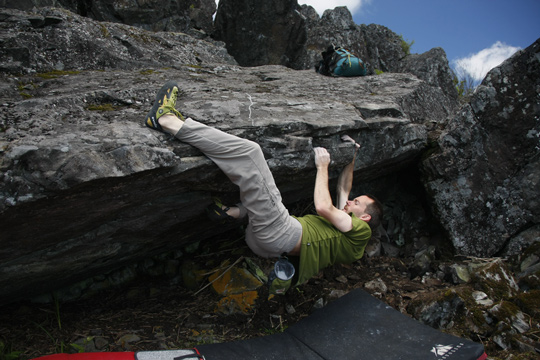
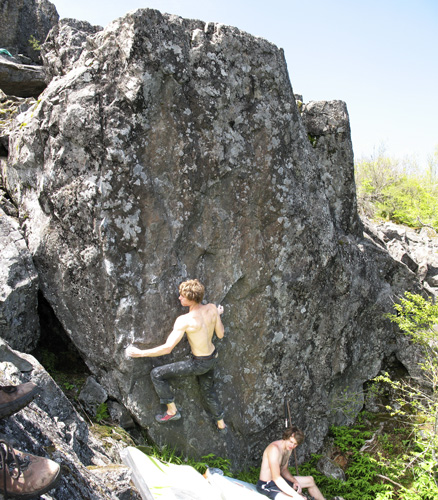
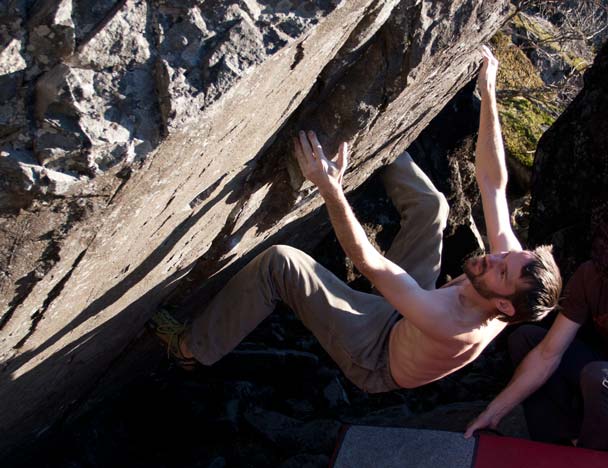
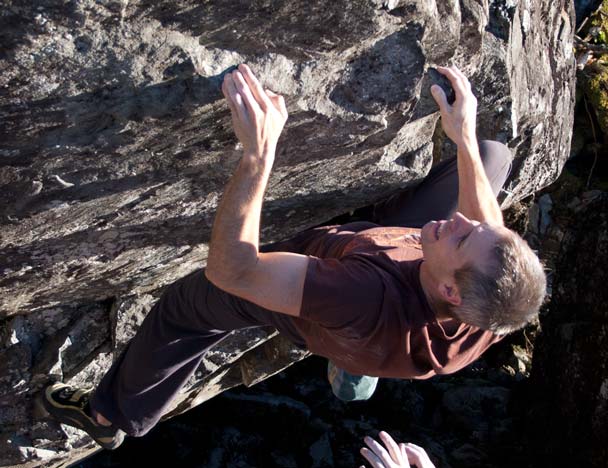
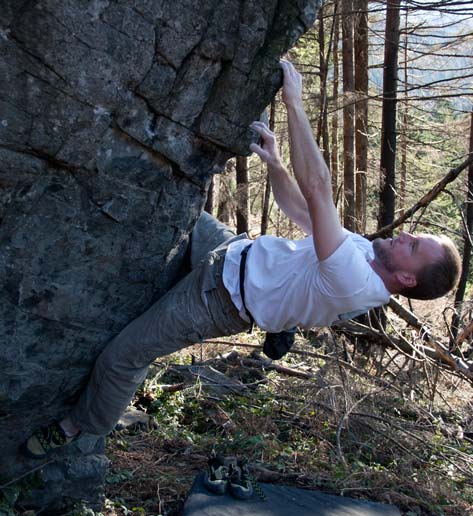
Hamilton Boulders is a quality site near Beacon Rock located within the state park, but at the upper Equestrian and Hikers Parking site. The site offers easily 100+ boulder problems of all styles and flavors, ranging from VB to V10+. The rare distinction about this site is its year-round accessibility. Its low elevation (just what Portlander's needed), south-facing sunny aspect, good quality spectrum of friction-friendly andesite rock offering a wild plethoric variety of lines from crimpy delicate face smears, fun basic runs, tall lines, to overhung problems of all degrees.
Directions to HB: Drive east from Vancouver, WA on State Route 14 for 35 miles to Beacon Rock. Turn left (north) onto Kueffler Road, and drive 1 mile uphill, then turn right onto a gravel road (at state park sign) and continue for about 1/4 mile to the Horse Camp and hiking trail parking lot. This is a Washington State Park fee site and you can attain this permit here at the parking site. The parking spot is fairly popular for hikers and equestrians. Walk north past the white gate along a gravel road for 200', then cut left (you will see the boulderfield ahead of you) into the forest on a faint path that leads over to the boulderfield. The first string of boulders begins just as you step up onto the south sloping boulderfield. Walk west along the path to reach the primary amphitheater, a concentrated core area packed with a plethora of problems. You will likely spend most of your time in this general vicinity as this area yields upwards of 60+ problems in this amphitheater, while another 35-40+ lines exist on the upper plateau (the entire area has plenty of future potential yet).
Magma Zone is an infrequently visited site, composed of short vertical basalt wall, developed by Mr Pajunas, and located on the north side of Broughton Bluff (3/4 mile east along the trail behind the rest room facility). It was more popular back when it was initially developed in the late 90s, but some moss regrowth (and a tricky to find uphill path) has made it relatively unappealing and seldom visited. But its local, and it might be a viable backup plan if you only have time for a short evening session.
Horsethief Butte near The Dalles on the Washington side of the Columbia River is a popular site to rock climb and boulder. It may be a bit of a boiler plate in summer, but Fall, Winter, and Spring offer plenty of sunny opportunities to practice on the quality string of boulder problems at the Butte. This site is a good place to work the slick-as-a-slug short basalt problems. There are plenty of variables, mostly ranging from VB-V5, some cool pumpy traverses, and several classic vertical lines.
The Garden is a long time favorite haunt near Sweet Home east of Albany. The boulders at the main area are packed in a dense cluster and many are quite large, tall enough for roped climbing on some. The densely packed cluster of boulders offer a vast string of quality problems on rhyolitic rock. Though the site is often too damp to use in the rainy season because of the overgrowth of maple trees surrounding the site, the warmer months are great.
Bulo Point boulders offers a cool high altitude selection of quality boulder problems. Nestled in the ponderosa pine trees on the east side of the Cascade Mtns south of FS44 road this site is a gem primarily for rock climbing, but has become a common site for bouldering as well on a minor selection of outcrops near the main crag formation.
West Fork Boulders is a well tapped site that has about 8 large boulders (10' - 13' tall).
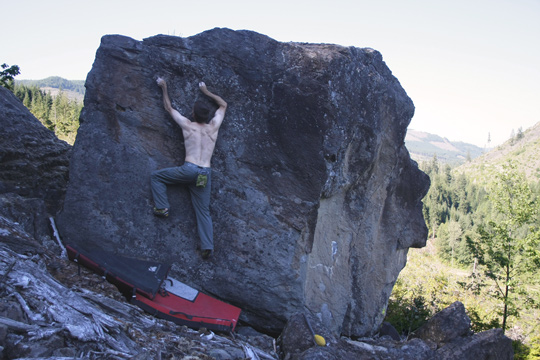 The site offers a good opportunity to escape the wet Spring rains or early Fall showers.
The West Fork site has a considerable string of developed problems, yet there are a few raw lines (mostly on the first monster block near the road) afloat.
The rock is quality lightly textured andesite, offering problems ranging from VB to V7.
The Hood River valley can be hot from June-Sept so pick a cool temperate day if you plan to be there in the Summer season.
The site is convenient for persons living near Hood River, or for the traveling Portlander who is heading east for a weekend day.
The road is paved the entire distance (via Hood River) to the site, and has a mere 2-minute approach hike.
The site offers a good opportunity to escape the wet Spring rains or early Fall showers.
The West Fork site has a considerable string of developed problems, yet there are a few raw lines (mostly on the first monster block near the road) afloat.
The rock is quality lightly textured andesite, offering problems ranging from VB to V7.
The Hood River valley can be hot from June-Sept so pick a cool temperate day if you plan to be there in the Summer season.
The site is convenient for persons living near Hood River, or for the traveling Portlander who is heading east for a weekend day.
The road is paved the entire distance (via Hood River) to the site, and has a mere 2-minute approach hike.
Check out Portland Bouldering, Mountainproject.com or Rockclimbing.com for additional info on various bouldering sites.
